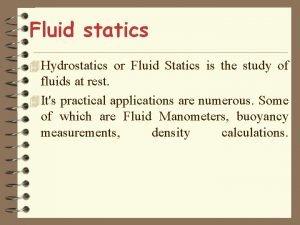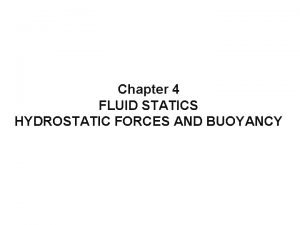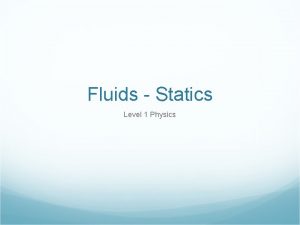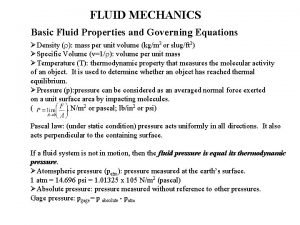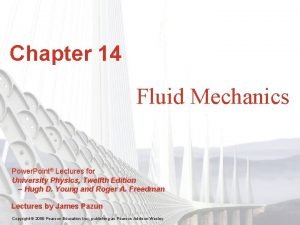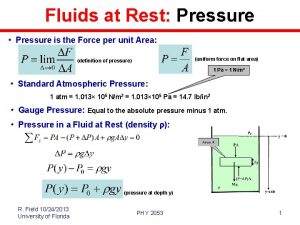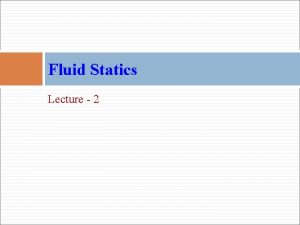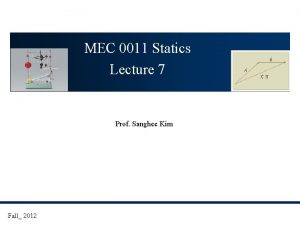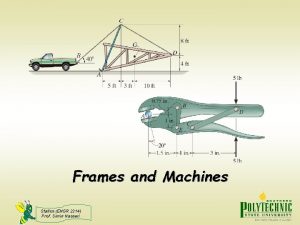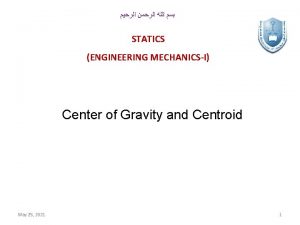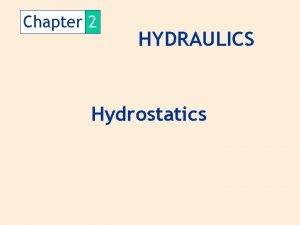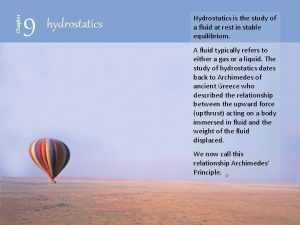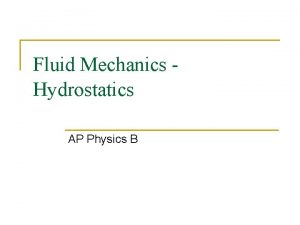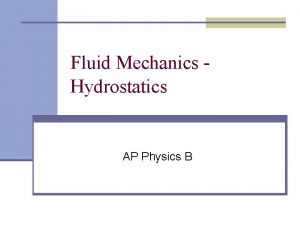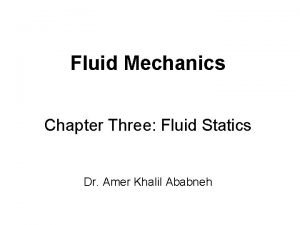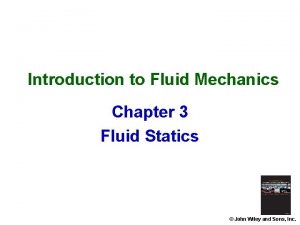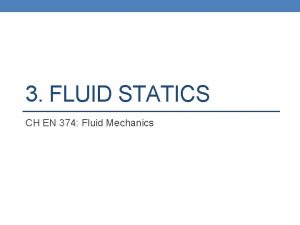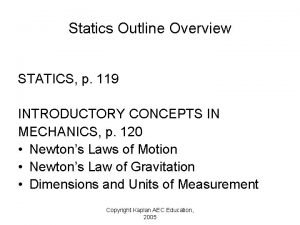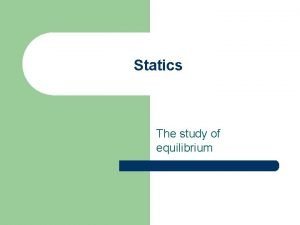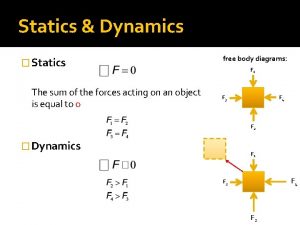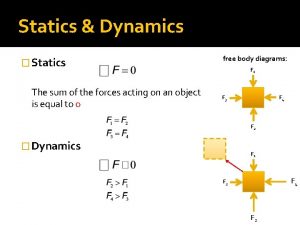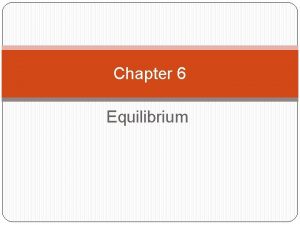Fluid statics 4 Hydrostatics or Fluid Statics is






























- Slides: 30

Fluid statics 4 Hydrostatics or Fluid Statics is the study of fluids at rest. 4 It's practical applications are numerous. Some of which are Fluid Manometers, buoyancy measurements, density calculations.

Fluid Elements - Definition: 4 Fluid element 4 - Body Force: 4 Surface Force 4

Fluid Elements - Definition: 4 Fluid element can be defined as an infinitesimal region of the fluid continuum in isolation from its surroundings. 4 Two types of forces exist on fluid elements Body Force: distributed over the entire mass or volume of the element. It is usually expressed per unit mass of the element or medium upon which the forces act. Example: Gravitational Force, Electromagnetic force fields etc.

Fluid Elements - Definition: Surface Force: Forces exerted on the fluid element by its surroundings through direct contact at the surface. Surface force has two components: – Normal Force: along the normal to the area – Shear Force: along the plane of the area. The ratios of these forces and the elemental area in the limit of the area tending to zero are called the normal and shear stresses respectively.

Pascal's Law of Hydrostatics The states that the normal stresses at any point in a fluid element at rest are directed towards the point from all directions and they are of the equal magnitude.

Pascal's Law of Hydrostatics Let us prove this law by considering the equilibrium of a small fluid element shown in Figure below.

Pascal's Law of Hydrostatics

Pascal's Law of Hydrostatics Also, Summing the forces yields

Pascal's Law of Hydrostatics…. Since the volume of the fluids is very small, the weight of the element is negligible in comparison with other force terms. So the above Equation becomes Py = P n Hence, P n = P x = P y Similar relation can be derived for the z-axis direction. This law is valid for the cases of fluid flow where shear stresses do not exist. The cases are • Fluid at rest. • No relative motion exists between different fluid layers. For example, fluid at a constant linear acceleration in a container. • Ideal fluid flow where viscous force is negligible.

Basic equations of fluid statics

Basic equations of fluid statics 4 The body force is given by 4 The surface force

Basic equations of fluid statics 4 When only the first two terms become significant. The above equation becomes 4 Similarly, pressures at the center of all the faces can be derived in terms of P (x, y, z) and its gradient.

Basic equations of fluid statics… 4 When only the first two terms become significant. The above equation becomes 4 Similarly, pressures at the center of all the faces can be derived in terms of P (x, y, z) and its gradient…. Note

Basic equations of fluid statics… 4 Similarly the surface forces on the other two directions (x and z) will be 4 The surface force which is the vectorical sum of the force scalar components.

Basic equations of fluid statics… 4 The total force acting on the fluid is 4 The total force per unit volume is. 4 For a static fluid, d. F=0. 4 Then,

Basic equations of fluid statics…

Basic equations of fluid statics… If acceleration due to gravity is expressed as , the components in the x, y and z directions will be 4 …. * 4 …. . . ** 4 …. . *** 4 The above equations (*, ***) are the basic equation for a fluid at rest.

Basic equations of fluid statics… If the gravity is aligned with one of the coordinate axis, for example z- axis, then 4 The component equations are reduced to

Basic equations of fluid statics… This simplification is valid under the following conditions. 4 Static fluid 4 Gravity is the only body force. 4 The z-axis is vertical and upward.

Scales of pressure measurement 4 Fluid pressures can be measured with reference to any arbitrary datum. The common datum are • Absolute zero pressure. • Local atmospheric pressure 4 When absolute zero (complete vacuum) is used as a datum, the pressure difference is called an absolute pressure, Pabs. 4 When the pressure difference is measured either above or below local atmospheric pressure, P local , as a datum, it is called the gauge pressure.

Scales of pressure measurement 4 Local atmospheric pressure can be measured by mercury barometer. 4 At sea level, under normal conditions, the atmospheric pressure is approximately 101. 043 k. Pa. 4 As illustrated in the earlier Figure, Note that if the absolute pressure is below the local pressure then the pressure difference is known as vacuum suction pressure.

Units and scales of Pressure Measurement Pascal (N/m^2) is the unit of pressure. Pressure is usually expressed with reference to either absolute zero pressure (a complete vacuum)or local atmospheric pressure. The absolute pressure: It is the difference between the value of the pressure and the absolute zero pressure. Gauge pressure: It is the diference between the value of the pressure and the local atmospheric pressure(patm)

Units and scales of Pressure Measurement Vacuum Pressure: If then the gauge pressure becomes negative and is called the vacuum pressure. But one should always remember that hydrostatic pressure is always compressive in nature Fig. The scale of pressure

Fluid statics

Fluid Statics: Example 1 4 Convert a pressure head of 10 m of water column to kerosene 4 4 4 4 of specific gravity 0. 8 and carbon-tetra-chloride of specific gravity of 1. 62. Solution : Given data: Height of water column, h 1 = 10 m Specific gravity of water s 1 = 1. 0 Specific gravity of kerosene s 2 = 0. 8 Specific gravity of carbon-tetra-chloride, s 3 = 1. 62

Fluid Statics: Example 2 4 Determine (a) the gauge pressure and (b) The absolute pressure of water at a depth of 9 m from the surface. Solution : 4 Given data: Depth of water = 9 m The density of water = 998. 2 kg/m 3 And acceleration due to gravity = 9. 81 m/s 2 Thus the pressure at that depth due to the overlying water is = 88. 131 k. N/m 2 4

Fluid Statics: Example 2… 4 Case a) as already discussed, gauge pressure is the pressure above the normal atmospheric pressure. Thus, the gauge pressure at that depth = 88. 131 k. N/m 2 4 Case b) The standard atmospheric pressure is 101. 213 k. N/m 2 Thus, the absolute pressure as P abs = 88. 131+101. 213 = 189. 344 k. N/m 2 4 Answer: 88. 131 k. N/m 2 ; 101. 213 k. N/m 2

Bernoulli’s Principle 4 In fluid dynamics, Bernoulli's principle states that for an inviscid flow, an increase in the speed of the fluid occurs simultaneously with a decrease in pressure.

Bernoulli's Principle : Real life Applications 4 Among the most famous applications of Bernoulli's principle is its use in aerodynamics 4 Though applications of Bernoulli's principle are among the most dramatic examples of fluid mechanics in operation, the everyday world is filled with instances of other ideas at work. Pascal's principle, for instance, can be seen in the operation of any number of machines that represent variations on the idea of a hydraulic press. Among these is the hydraulic jack used to raise a car off the floor of an auto mechanic's shop. Exercise 4 List Four (4) applications of the Bernoulli’s Principles

Pressure variations in an incompressible fluid at rest 4 In some fluid problems, fluids may be considered homogenous and incompressible i. e . density is constant. Pressure variations in an incompressible fluid at rest 4 This indicates that the pressure increases linearly from the free surface in an incompressible static fluid as illustrated by the linear distribution in the above figure.
 Example of fluid statics
Example of fluid statics How does a straw work physics
How does a straw work physics Fluid statics deals with fluid at rest
Fluid statics deals with fluid at rest Fluid statics deals with fluid at rest
Fluid statics deals with fluid at rest Fluid statics deals with
Fluid statics deals with Pressure vs depth equation
Pressure vs depth equation Pressure gradient fluid mechanics
Pressure gradient fluid mechanics Fluid kinematics ppt
Fluid kinematics ppt Liquid pressure unit
Liquid pressure unit Fluid statics physics
Fluid statics physics Examples of fluid statics
Examples of fluid statics Fluid thrill meaning
Fluid thrill meaning Bioimpedância
Bioimpedância Fluid mechanics chapter 4 solutions
Fluid mechanics chapter 4 solutions Interstitial fluid vs extracellular fluid
Interstitial fluid vs extracellular fluid Synovial fluid
Synovial fluid Movement of body fluids
Movement of body fluids Transcellular fluid
Transcellular fluid Force system in mechanics
Force system in mechanics Statics centroid
Statics centroid Statics
Statics Statics
Statics Select the correct fbd of particle a
Select the correct fbd of particle a Forces acting at a point in statics
Forces acting at a point in statics Statics frames
Statics frames Statics wedge problems
Statics wedge problems Vector mechanics
Vector mechanics Statics
Statics Static mechanics
Static mechanics Analysis of internal forces
Analysis of internal forces 보의 종류
보의 종류
